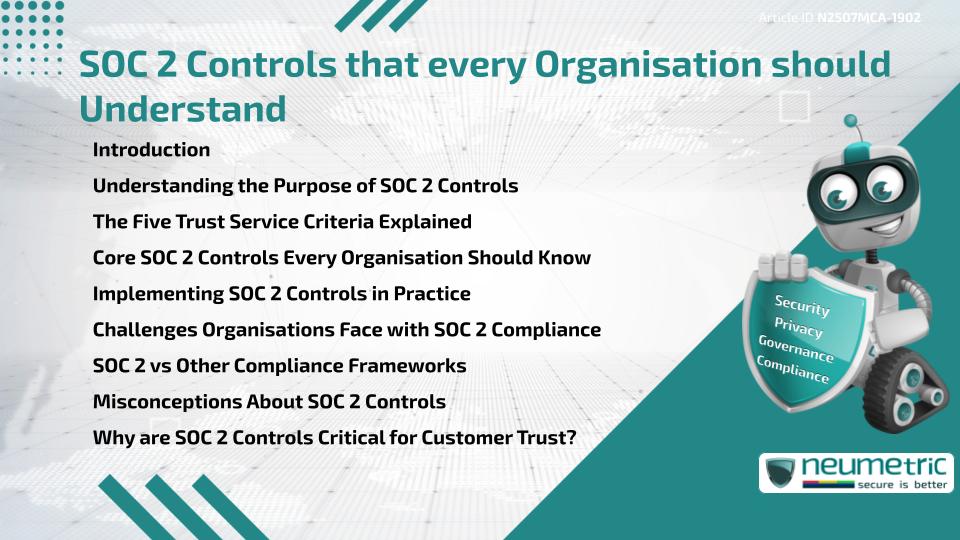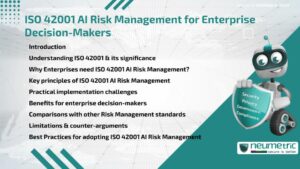Table of Contents
ToggleIntroduction
SOC 2 Controls are essential for any Organisation that handles Customer Data in the Cloud or provides Technology Services. Developed by the American Institute of Certified Public Accountants [AICPA], SOC 2 focuses on ensuring Systems are Secure, Available & Confidential. Understanding these Controls is key to achieving & maintaining Compliance with modern Data Protection Standards.
This Article provides a clear overview of SOC 2 Controls, explains their connection to the Trust Service Criteria, explores common Challenges & clears up Misconceptions. Whether you are preparing for a SOC 2 Audit or simply looking to boost your Organisation’s Credibility, knowing these Controls will help protect your Operations & your Customers’ Trust.
Understanding the Purpose of SOC 2 Controls
SOC 2 Controls are structured Processes, Procedures & Policies that help Organisations demonstrate effective Data Protection. Unlike some rigid Regulatory Frameworks, SOC 2 is adaptable to the specific needs of each Service Provider.
The main objective is to ensure the Service Organisation’s System is designed & operated in accordance with the five Trust Service Criteria. These Controls help Stakeholders determine whether appropriate Safeguards are in place & functioning over time.
While SOC 2 is not legally mandated, it is often requested by Clients & Partners who want Assurance that their Data is managed responsibly.
The Five Trust Service Criteria Explained
SOC 2 Controls are organised around five (5) Trust Service Criteria. Each Criterion includes specific Control Objectives that an Organisation should meet:
Security
The only mandatory Criterion, Security involves measures to protect Systems from unauthorised Access. These include Firewalls, Intrusion Detection & Multi-Factor Authentication.
Availability
This ensures Systems are accessible for Operation & Use as committed. Controls here focus on Disaster Recovery, Performance Monitoring & Capacity Planning.
Processing Integrity
It relates to the Completeness, Accuracy & Timeliness of Data Processing. Typical Controls include Quality Assurance Checks & System Validation.
Confidentiality
Controls under this Criterion protect Sensitive Information shared by Customers or processed by the Service Organisation. Encryption, Access Restrictions & Data Retention Policies are common here.
Privacy
This refers to how Personal Data is collected, stored, used & disclosed. Controls must align with Privacy Principles such as Notice, Choice & Consent.
Core SOC 2 Controls Every Organisation Should Know
Not every SOC 2 Report includes all five Trust Service Criteria, but Security is always evaluated. Key SOC 2 Controls include:
- Access Control Policies: Defining who can access which Systems & Data.
- Change Management Procedures: Ensuring System Changes are tested & documented.
- Incident Response Plans: Providing a clear path for identifying & managing Security Breaches.
- Monitoring Systems: Tracking User Activity, Performance & Security Events.
- Risk Assessment Processes: Regularly reviewing Threats & Vulnerabilities.
- Encryption Standards: Securing Data at Rest & in Transit.
Organisations should tailor these Controls to fit their Infrastructure while ensuring they meet the Control Objectives.
Implementing SOC 2 Controls in Practice
Applying SOC 2 Controls effectively requires cross-functional Cooperation. Information Technology [IT], Human Resources [HR], Legal & Security Teams all contribute to maintaining Compliance.
Steps to Implementation include:
- Gap Assessment: Identifying missing Controls or Policies.
- Policy Development: Creating Documentation for Security & Privacy Practices.
- Tool Deployment: Using Monitoring, Logging & Access Management Tools.
- Training & Awareness: Educating Staff on Responsibilities.
- Ongoing Evaluation: Conducting Internal Audits & updating Controls as Systems evolve.
Many Organisations also choose to engage Third Party Auditors or Consultants to guide their Compliance Journey.
Challenges Organisations Face with SOC 2 Compliance
While SOC 2 Controls are flexible, they are not always easy to implement. Common Challenges include:
- Resource Constraints: Smaller Organisations may lack Time or Staff.
- Documentation Burden: Auditors require detailed, well-organised Evidence.
- Technology Limitations: Legacy Systems may not support modern Control Implementations.
- Cultural Resistance: Teams may resist Changes to long-standing Processes.
Overcoming these Challenges requires strong Leadership, Training & a commitment to a Security-First Mindset.
SOC 2 vs Other Compliance Frameworks
SOC 2 often gets compared to other Frameworks like ISO 27001, PCI DSS & HIPAA. Here is how they differ:
- SOC 2 is Principles-Based & adaptable, suited for Service Providers.
- ISO 27001 is a Global Standard focused on Continuous Improvement of an Information Security Management System [ISMS].
- PCI DSS is specific to Payment Card Data Security.
- HIPAA governs Protected Health Information within Healthcare.
Unlike Prescriptive Standards, SOC 2 lets Organisations define how they meet the Control Objectives-making it both flexible & complex.
Misconceptions About SOC 2 Controls
Many Organisations misunderstand what SOC 2 Compliance truly involves. Common Misconceptions include:
- “SOC 2 is a Certification”: It is not. You receive an Audit Report, not a Certification.
- “All Criteria are mandatory”: Only Security is required; the others are optional.
- “SOC 2 is only for large Enterprises”: Any Cloud or Technology Company can benefit.
- “One-time effort is enough”: SOC 2 requires ongoing effort & reevaluation.
Clearing up these Misunderstandings helps Organisations prepare better for Compliance & reduce Audit stress.
Why are SOC 2 Controls Critical for Customer Trust?
In today’s Digital Environment, Customer Trust is directly linked to Data Handling Practices. SOC 2 Controls provide a recognised way for Service Organisations to demonstrate Accountability, Transparency & Reliability.
By adhering to these Controls, Organisations signal their commitment to high Standards of Information Security & Privacy. This not only improves Internal Processes but also strengthens Relationships with Customers, Partners & Regulators.
Takeaways
- SOC 2 Controls are built around five Trust Service Criteria, with Security being mandatory.
- These Controls are not Prescriptive but must meet specific Objectives.
- Effective Implementation involves People, Processes & Technology.
- SOC 2 Compliance is a Journey that requires ongoing effort.
- Understanding & applying SOC 2 Controls builds Organisational Trust & Resilience.
FAQ
What are SOC 2 Controls?
SOC 2 Controls are Processes & Policies that help Organisations meet the Requirements of the five Trust Service Criteria set by AICPA.
Is SOC 2 compliance mandatory?
SOC 2 Compliance is not legally required but is often demanded by Customers or Partners as proof of good Data Governance.
Which Trust Service Criterion is required in all SOC 2 reports?
Security is the only mandatory Criterion in all SOC 2 Reports.
How often should SOC 2 Controls be reviewed?
SOC 2 Controls should be reviewed at least annually or whenever significant Changes occur in your Systems or Operations.
Can startups achieve SOC 2 compliance?
Yes, Startups & Small Organisations can & should pursue SOC 2 Compliance if they handle Customer Data or provide Cloud-Based Services.
What is the difference between Type I & Type II reports?
Type I Reports assess Design of Controls at a point in Time. Type II Reports assess Operational Effectiveness over a period (usually six to twelve months).
How long does it take to become SOC 2 compliant?
It typically takes between three (3) to nine (9) months, depending on the Organisation’s Size & Readiness.
Need help for Security, Privacy, Governance & VAPT?
Neumetric provides organisations the necessary help to achieve their Cybersecurity, Compliance, Governance, Privacy, Certifications & Pentesting needs.
Organisations & Businesses, specifically those which provide SaaS & AI Solutions in the Fintech, BFSI & other regulated sectors, usually need a Cybersecurity Partner for meeting & maintaining the ongoing Security & Privacy needs & requirements of their Enterprise Clients & Privacy conscious Customers.
SOC 2, ISO 27001, ISO 42001, NIST, HIPAA, HECVAT, EU GDPR are some of the Frameworks that are served by Fusion – a SaaS, multimodular, multitenant, centralised, automated, Cybersecurity & Compliance Management system.
Neumetric also provides Expert Services for technical security which covers VAPT for Web Applications, APIs, iOS & Android Mobile Apps, Security Testing for AWS & other Cloud Environments & Cloud Infrastructure & other similar scopes.
Reach out to us by Email or filling out the Contact Form…





